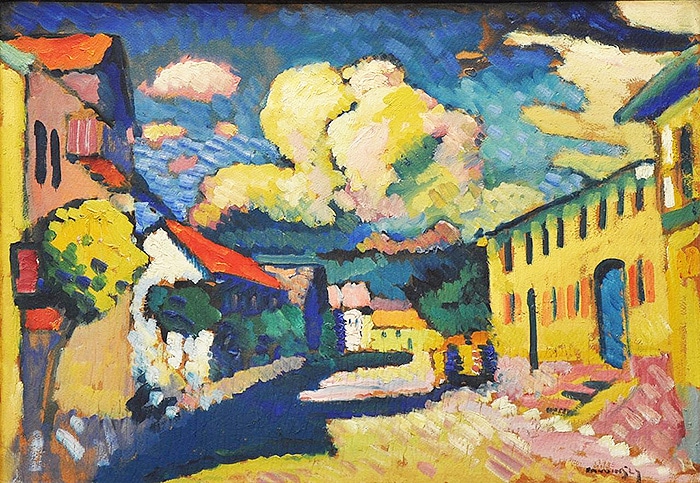Happy Birthday Mr. Kandinsky!
The Nazmiyal Antique Rugs wishes to highlight the birthday of Wassily Kandinsky, lauded Russian abstract artist of the 20th century. To celebrate the late artists’ 148th birthday, we’ve featured the Kandinsky rugs and textiles in our collection.
Wassily Kandinsky was born on this day, December 16th, in the year 1866 to a tea merchant family in Moscow. As a child, he had a voracious appetite for knowledge, and was a skilled student in many different subjects. He would, in his later life, recall being fascinated by the vibrancy of color from a very young age. As he grew, he became more specifically interested in the psychological effects of color, and spoke often of different hues eliciting different emotions and reactions from the human mind. Kandinsky once stated, “colour is the keyboard, the eyes are the hammers, the soul is the piano with many strings. The artist is the hand which plays, touching one key or another, to cause vibrations in the soul”.
In addition to his interest in psychology, Kandinsky was also highly influenced by Russian folk art styles, specifically, those of the Vologda region, located north of Moscow. He was inspired by the way folk artists in this area painted bright hues onto dark backgrounds, creating high-contrast pieces that evoked a feeling of intense energy and vibration. His experience in Volgoda would be an important source of inspiration for the young painter.
Although Kandinsky was interested in painting from a young age and engaged in it as a hobby, in his early life his career goal was to become a professor of law and economics, which he accomplished at a young age. During his mid twenties, Kandinsky accepted a position at the University of Dorpat, and was considered by his colleagues an intelligent and successful man. However, his desire to create artwork and explore his inspirations became more powerful, and at age 30 he left his teaching position to pursue a career in the arts.
After leaving his professorship, Kandinsky applied to a Munich art school, but was not accepted immediately. Undeterred by this setback, Kandinsky began independently studying art history and color theory. During this time, he visited an exhibit of Monet’s work, which he found particularly inspiring. This encounter with Monet was Kandinsky’s first taste of abstraction, which evoked in him with a complex mix anger and awe. Kandinsky stated about Monet’s painting, The Haystack:
“I could not recognize it. This non-recognition was painful to me. I considered that the painter had
no right to paint indistinctly. I dully felt that the object of the painting was missing. And I noticed with
surprise and confusion that the picture not only gripped me, but impressed itself inextricably on my
memory.”
Eventually, Kandinsky was accepted into the Munich School, and began his formal arts education. He found classes quite easy, and so had time to develop as not only a painter, but an art theorist as well. He remained interested in the way in which color and stroke could influence the feeling of movement and emotion in artwork. Many of his early paintings from this period are still in existence, and depict recognizable but highly impressionistic landscapes. His level of abstraction in these works are indicative of his admiration for Monet’s work, but his colors are more reminiscent of the bright folkloric paintings he was introduced to as a child, and were also influenced by the emerging Fauvist movement, which was focused on the use of intense, evocative color to establish mood.

Vassily Kandinsky 1908 Murnau Dorfstrasse Painting
After his schooling, Kandinsky traveled throughout Europe, painting landscapes, before settling in the Bavarian town of Murnau. During this period, he continued to paint landscapes, and his work evolved into a higher form of abstraction. He stopped using lines almost completely, instead choosing to let color and shape define his compositions. He also continued his studies as an art theorist, and contributed important work to the field of art history, including founding two arts organizations, The Munich New Artists Association, and the Blue Rider, which held two exhibits and released multiple theoretical works, including The Blue Rider Almanac and Kandinsky’s most important text, Treatise on the Spiritual in Art, which acted as a defense of abstraction and a promotion of the power of color. Unfortunately, the outbreak of World War I put an end to The Blue Rider organization, as Europe spiraled into turmoil.
After the war, Kandinsky returned to Russia and focused on teaching and fine arts cultural reform — he did very little painting during this time. After a short period, however, Kandinsky’s style of teaching and ideas about art theory proved to be too radical for the Russian government, which led to his termination. Western Europe proved to be much more tolerant of Kandinsky’s artistic goals, and he was invited to study at the Bauhaus school by its founder, Walter Gropius. It was here that Kandinsky’s interest in abstraction and geometry flourished, and his works evolved to be much more about shape and psychology than recognizable landscape.
Kandinsky was successful during his time at the Bauhaus school, and taught design, theory and painting classes. However, in the early 1930’s, with the rise of Nazi power in Germany, the school was the target of a smear campaign, and was forced to disband. Kandinsky resettled in Paris, where he remained until his death in 1944. Some of his most well-known works were created during his years in Paris, including his Compositions series.
Nazmiyal is proud to have multiple Kandinsky-designed rug editions in its collection. Wassily Kandinsky was a true pioneer in the field of abstraction, and his influence and impact on art and color theory can still be felt today. Happy birthday Mr. Kandinsky!
What do you think of Kandinsky’s work as a painter and designer? Tell us in the comments!




